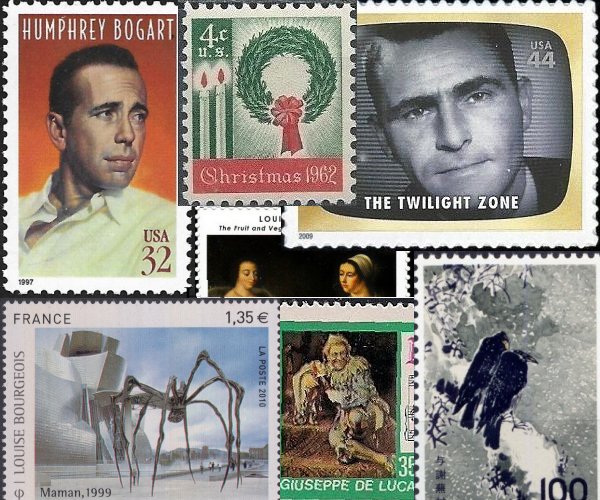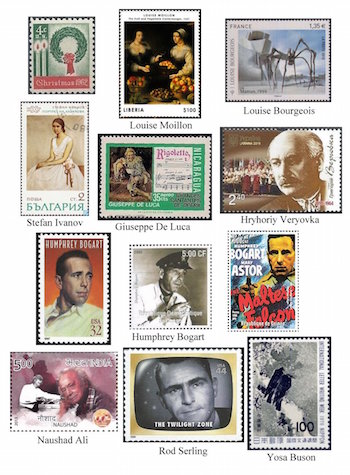The Arts on Stamps of the World — December 25
An Arts Fuse regular feature: the arts on stamps of the world.

By Doug Briscoe
There are literally many hundreds of different Christmas stamp designs from all over the world. Here is the very first US Christmas stamp, issued in 1962.
We have two women artists on the program today, both of French ethnicity, both of them named Louise, one from the 17th century and one from our own time. Actually, the birth date of Louise Moillon (1609–1696) is not known for certain. One source cites December 25th or January 1st, and her death can’t be narrowed down beyond December 20th or 21st. In any case she earned a reputation during her own lifetime as one of the finest painters of still life. Initially she learned from her father, but he died when Louise was 10, and her career might never have begun had her mother not remarried another painter, the art dealer Francois Garnier, who continued to give Louise instruction in painting. Most of Moillon’s work predates her own marriage in 1640, but she did produce more paintings after that, the last dated one from 1674. She was patronized by the French nobility, and at least one of her canvases was bought by Charles I of England.The Liberian stamp offers a piece that does include human figures, The Fruit and Vegetable Costermonger of 1631. (Ah, where are the costermongers of yesteryear?) It’s at the Louvre. Here, too, are some scrumptious plates of Cherries, Strawberries, and Gooseberries (1630), plums, and peaches.
I suppose we may as well leap ahead to our latter day Louise. Louise Bourgeois (25 December 1911 – 31 May 2010) was born in Paris. Her parents were tapestry dealers, and Louise learned the process of restoration. She studied mathematics at the Sorbonne, but after her mother died in 1932 Bourgeois turned to art. It was Fernand Léger who told her she was more of a sculptor than a painter. She opened a shop selling prints and there met her husband, the American art historian Robert Goldwater. They married in the year they met, 1938, and moved to New York. Bourgeois had her first solo show in 1940. The work chosen for the French stamp is one that exists in a number of versions, this one inhabiting a space outside the Guggenheim Museum in Bilbao. It’s called Maman. Perhaps anticipating the viewer’s reaction to the artist’s unconventional representation of motherhood, Bourgeois wrote, “The Spider is an ode to my mother. She was my best friend. Like a spider, my mother was a weaver… Like spiders, my mother was very clever. Spiders are friendly presences that eat mosquitoes… So, spiders are helpful and protective, just like my mother.”
The Bulgarian painter Stefan Ivanov (1875 – 14 Juli 1951) was born on Christmas and died on Bastille Day, make of that what you will. He was a graduate of the Sofia Arts Academy in 1901 and taught there from 1906. His output encompasses portraits, landscapes, still lifes, and nudes, but also politically informed pictures. On the stamp we see his Portrait of Lazarova (1927).
The great Italian baritone Giuseppe De Luca was born in Rome in 1876. He sang at La Scala from 1902 to 1910 and at the Met from 1915 to 1935. He twice created roles in Puccini operas: he was the first Sharpless in Madama Butterfly (La Scala, 1904) and the first Gianni Schicchi (at the Met in 1918). He left a substantial body of recordings made from the 1900s to the 30s. The stamp is one from a set issued by Nicaragua in 1975 honoring great operatic stars. Giuseppe De Luca died on 26 August 1950.
Hryhoriy ( = Gregory) Veryovka (1895 – October 21, 1964) was a Ukrainian composer and choir director, founder and leader of the Veryovka Choir (aka the Ukrainian State Folk Choir). He taught at various institutions, notably at the Kyiv Conservatory. His compositions, besides many choruses and folk song arrangements, include a cantata, “We are blacksmiths of his fate”, with an orchestra of folk instruments, and a Folk Song Suite for orchestra (1929).

Just yesterday we displayed a Casablanca stamp to recognize the birthday of director Michael Curtiz, so today, for Humphrey Bogart (December 25, 1899 – January 14, 1957) we’ll omit that one and offer three others: a US stamp from 1997, a Congolese issue from 2002, and a stamp from the Republic of Guinea citing The Maltese Falcon (though I make bold to say that Bogart’s image here is taken from another movie). (Another loose connection with yesterday’s Arts Fuse piece is that Bogart attended Phillips Academy in Andover, though he was expelled years before Paul Manship’s Venus Anadyomene fountain was installed there in 1931.) Bogart stumbled into acting without any particular goals and without training. Films followed a dozen-year career on Broadway, where Bogart played a series of lightweight characters “in white pants swinging a tennis racquet.” In a curious reversal, he would shed that typecasting only to assume another as a gangster after playing Duke Mantee in The Petrified Forest (1934). In real life, though a heavy drinker, Bogart was an avid reader, a strong chess player, and loved Bach and Debussy.
Indian musician Naushad Ali (25 December 1919 – 5 May 2006), or just Naushad, was a seminal force in Hindi film music. He was born in Lucknow to a strict Muslim household where music was frowned upon, and eventually, but not before receiving some musical training, Naushad left home at 17 to pursue his dream in Mumbai. He made his first musical contribution to film in 1940. By 1942 he was being credited as “music director” and in 1944 firmly established his reputation with the score for Rattan. Naushad was known for introducing music from the classical Indian tradition to Bollywood. His last score was for the historical film Taj Mahal (2005).
Every time I think of Rod Serling (December 25, 1924 – June 28, 1975) I am saddened that he didn’t have two or three more decades to ply his brilliant craft. He was born to a Jewish family in Syracuse and displayed a talent for dramatics from an early age, acting out dialogue from pulp magazine stories or movies. It wasn’t long before he started writing his own, but his introduction to theater was by way of Army service in the, ahem, Pacific Theater. He served in the Philippines (Battle of Leyte) and was wounded a couple of times, going on later to street fighting in Manila and joining the occupying force on the Japanese mainland. While in the army he had taken up boxing, which provided material for Playhouse 90’s “Requiem for a Heavyweight” in 1956. Serling’s great success a year earlier had been with “Patterns,” for Kraft Television Theatre. That, too, was to some extent a product of his army experience, the main character having been modeled on Serling’s commander. The broadcast of “Patterns” struck such a chord with audiences that in an unprecedented move, a second live broadcast (the first, in accordance with the practice of the time, had not been taped) was aired by popular demand a month later, thus ushering in the dubious practice of reruns. The Twilight Zone followed in 1959 and Night Gallery in 1969. In between, he wrote the superb screenplay (if occasionally a little soap-boxish) for Seven Days in May (1964), one of the roles going to yesterday’s birthday girl Ava Gardner. Serling also co-wrote the screenplay for the original Planet of the Apes (1968).
Sources disagree as to whether Japanese poet and painter Yosa Buson died on December 25, 1783 or on January 17, 1784. There is, though, no dispute (?) about his having been born during the year 1716. He studied poetry and emulated the wanderings of his idol, the great Bashō, keeping a diary as the older master had done. Buson would no doubt be pleased to know that he is held in high esteem alongside Bashō and Kobayashi Issa as one of the great poets of the Edo Period. A few of Buson’s drawings can be seen at the MFA. The left panel from his Black Hawk and Two Crows appears on a Japanese stamp for International Letter Writing Week 1976.
Two prominent American popular music entertainers share this Christmas birthday, Cab Calloway (December 25, 1907 – November 18, 1994) and Jimmy Buffett (born December 25, 1946).
A graduate of the University of Massachusetts with a B.A. in English, Doug Briscoe worked in Boston classical music radio, at WCRB, WGBH, and WBUR, for about 25 years, beginning in 1977. He has the curious distinction of having succeeded Robert J. Lurtsema twice, first as host of WGBH’s weekday morning classical music program in 1993, then as host of the weekend program when Robert J.’s health failed in 2000. Doug also wrote liner notes for several of the late Gunther Schuller’s GM Recordings releases as well as program notes for the Boston Classical Orchestra. For the past few years he’s been posting a Facebook “blog” of classical music on stamps of the world, which has now been expanded to encompass all the arts for The Arts Fuse.
